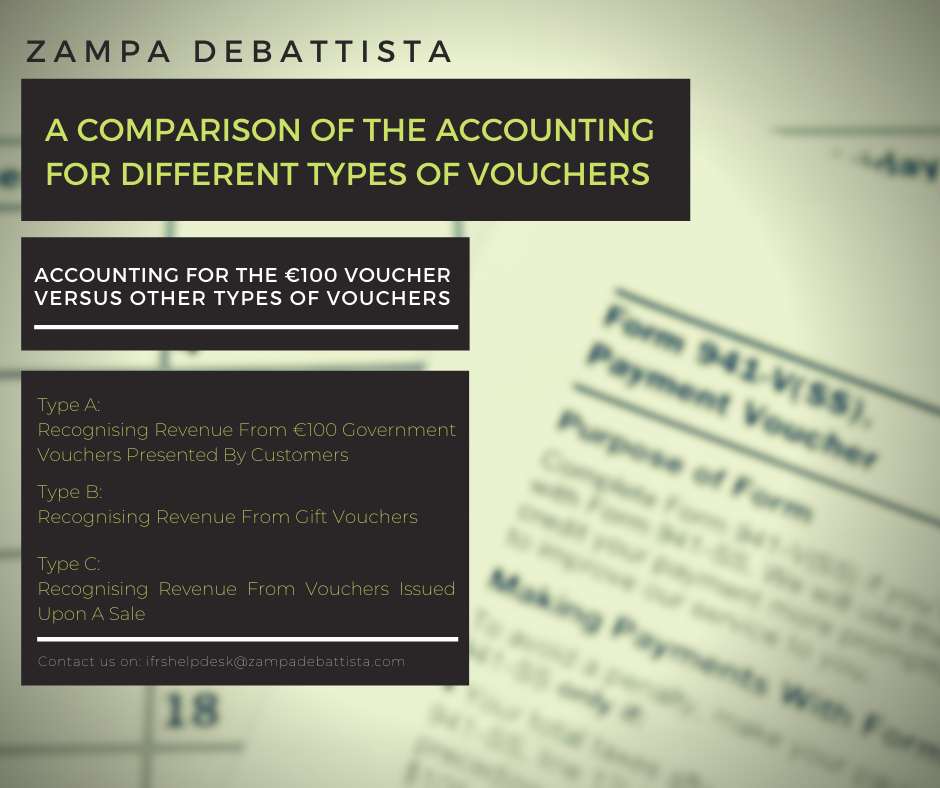The Maltese government has issued vouchers of €100 to everyone over the age of 16, as one of its measures implemented to regenerate the economy following the impact of the Coronavirus pandemic. Four of these vouchers can be spent at any establishment licensed under the Malta Tourism Authority, including hotels, restaurants, bars and diving schools. The remaining voucher can be spent at any business that was forced to close by legal notice during the COVID-19 pandemic.
How are Companies to account for such vouchers, in contrast with other types of vouchers (such as gift vouchers), under IFRS and GAPSME?
First of all, it needs to be mentioned that GAPSME doesn’t address the accounting for vouchers at all. However, GAPSME preparers are permitted to refer to IFRS to set their policies, in those circumstances in which GAPSME doesn’t provide sufficient guidance.
As a result, the following illustrations will be following IFRS guidance for vouchers.
We’ll tackle three different types of vouchers in our comparison:
Type A: Recognising Revenue From €100 Government Vouchers Presented By Customers
The accounting for this type of gift voucher is very straightforward. A restaurant normally books the following journal entry when selling to a customer (suppose the customer spends €40):
Debit Cash €40
Credit Sales €40
For those customers presenting the voucher, the journal entry would be the following:
Debit Receivable From Government €40
Credit Sales €40
There are no complications in terms of revenue accounting under IFRS 15 – the revenue is booked on the date of the meal.
On the receivables side, there should be no impairment implications, even under IFRS 9. A receivable from the government is almost always considered low credit risk. However, it needs to be mentioned that vouchers must be checked for authenticity under a UV light and establishments must not accept those that do not illuminate. If for some reason, an entity fails to implement controls to check that vouchers are authentic, it might have a few worthless vouchers in hand, which would be booked to profit or loss immediately.
At this stage, it is our understanding that receivables from government would be classified as short term, assuming that the length of time that the government will take to refund the establishments for all vouchers at reporting date will be within 12 months of that same reporting date.
We’re aware that some entities are offering further vouchers in addition to those provided by the government. For instance, certain entities are offering a further €20 voucher to a €20 government voucher presented by the client. Such further vouchers would be redeemable into goods or services provided by the entity. This type of gift voucher is tackled in ‘Type C’ below.
Type B: Recognising Revenue From Gift Vouchers
In the case of gift vouchers issued by the entity, the accounting treatment is more complex. Two dates need to be considered:
Date 1: The date of the purchase of the gift card – the entity receives cash from the purchaser and issues the gift voucher but does not transfer any goods or services.
Date 2: The date of the redemption of the gift card – the recipient of the gift voucher presents the voucher, and the entity transfers the goods or services.
The key matter to understand is that for each gift voucher circulated, date 1 is a certain event because the voucher has been circulated, whereas date 2 is not certain. In fact, the recipient of the gift voucher may or may not present the voucher by the expiry date.
On Date 1, the purchaser is paying cash to the Company. Upon this receipt, a contract liability is recognised, and not revenue.
On Date 2, revenue is recognised. This is the date on which the entity is performing, and thus transferring the goods or services. Since the entity is now fulfilling its promise, the contract liability is derecognised, and revenue is recognised.
The tricky aspect of such vouchers is that of breakages – in other words, how the entity accounts for customers that do not exercise the contractual rights.
The entity needs to consider breakages from date 1, if it is not obliged to refund for breakages. Locally, this is normally the case for gift vouchers. In such case, the entity recognises revenue based on expected breakages, in proportion to the pattern of rights exercised by the customer.
The following simple example illustrates accounting for typical gift card situations that have an expiry date. The entity has no obligation to refund any breakages:
Fragrant is a perfumery shop and began to offer gift cards to customers as from 1 July 2019. The company has a 31 December financial year-end.
Salient details:
> Gift card redemption period: 1 year.
> Gift cards issued on 1 July 2019: €300.
> Gift cards issued between 2 July 2019 and 31 December 2019: €0.
> Redemptions made up to 31 December 2019: €180.
> Expected breakage at 1 July 2019: 5% of the value of gift cards issued.
> Expected breakage at 31 December 2019: 5% of the value of gift cards issued.
How is such a situation accounted for?
Upon receipt of consideration for the gift cards, that is, on 1st July in this case:
Debit Cash €300
Credit Contract Liability €300
Once the expected breakages at reporting date is estimated, the estimated breakages on consideration received during the period can be calculated.
Estimated breakages = Expected breakages * Consideration received
= 5% * €300
= €15
The release of revenue at year-end turns out to be as follows:
31 December 2018 Debit Contract Liability €189
Credit Revenue €189
Why are we releasing €189 and not the amount redeemed (€180)? The reason is that we need to take our expected breakages into account. As per IFRS 15, Para. B46, “If the entity expects to be entitled to a breakage amount in a contract liability, the entity shall recognise the expected breakage amount as revenue in proportion to the pattern of rights exercised by the customer”.
The €189 of revenue released has two components:
> €180 representing the selling price of goods redeemed.
> €9 for expected breakages. Upon every redemption, the entity recognises additional revenue to the selling price of the goods redeemed, since there is an expectation that some of overall consideration received during the period will not be redeemed. The €9 is computed as per below:
‘Additional’ Revenue
= [Estimated Breakages * (Total Redemptions Made / Total Gift Cards Issued)]
= 15 * 180/300
The breakages in this contract are those situations whereby the customer paid consideration but did not follow up on his rights by redeeming the gift. To compute the adjustment to contract liability and revenue representing expected breakages, in this example we would calculate [Total Breakages * (Redemptions/Gift Cards Issued)], which is equal to €15 * €180/€300.
The breakage estimate would typically need to be adjusted at every period-end, and adjustments would need to be made accordingly.
Type C: Recognising Revenue From Vouchers Issued Upon A Sale
Suppose a Company operates a supermarket and a restaurant. Suppose there is an offer, whereby the purchase of €200 or more from the supermarket triggers a €10 voucher for a pizza from the restaurant. All pizzas are worth €10 on the menu.
Suppose a customer purchases €220 worth of goods from the supermarket, earning the right to a €10 voucher for a pizza.
For the purchase in question, the Company has two promises to fulfil:
> Promise 1: Transfer of supermarket goods.
> Promise 2: Transfer of pizza.
The transaction price of the contract with this customer is €220.
The Company needs to find the stand-alone selling prices of the two promises:
| Promise | Stand-Alone Selling Price | Revenue To Recognise |
| 1: Supermarket Goods | €220 | [€220/€230 * €220] = €210.43 |
| 2: Pizza | €10 | [€10/€230 * €220] = €9.57 |
Although cash received by the supermarket is €220, the revenue to be recognised upon the transfer is €210.43.
Debit Cash 220
Credit Revenue 210.43
Credit Contract Liability 9.57
The contract liability represents the obligation to deliver the pizza – it is important to note that this is not €10, but €9.57.
If there is the expectation that 100% of vouchers will be redeemed, the contract liability shall be released to revenue once the voucher is redeemed:
Debit Contract Liability 9.57
Credit Revenue 9.57
However, in reality, there is an element of breakage – not all customers will redeem the voucher.
Let’s add further details at Company level: suppose the Company’s aggregate contract liability representing vouchers issued to all those spending more than €200 from the supermarket at the end of 2020 is €16,000. Suppose that by the end of 2020, 24% of vouchers have been actually redeemed, and the Company expects that 60% of vouchers issued during 2020 shall be eventually redeemed.
The release of contract liability to revenue in 2020 should amount to 24/60 * 16,000 = €6,400.
The understanding is that the remaining 36% (60% expected redemption, less 24% already redeemed), will be released from contract liability to revenue in the subsequent years.
Of course, the expectation of 60%, needs to be reassessed annually, and accounted for as a change in accounting estimate (that is, prospectively, in line with IAS 8 ‘Accounting Policies, Changes In Accounting Estimates And Errors’). Therefore, if at the end of 2021, 50% of those vouchers issued in 2020 have been redeemed, and we expect 55% to be the percentage of 2020 vouchers that will ultimately be redeemed, the total contract liability released to revenue by 31 December 2021 shall be 50/55*16,000 = €14,545. Therefore, an adjustment of the movement from €6,400 to €14,545 will be the adjustment to pass at the end of 2021:
Debit Contract Liability 8,145
Credit Revenue 8,145
DISCLAIMER: Please note that this article is being published for information purposes only. As such it does not constitute or is to be interpreted or construed as legal advice or guidance. ZD does not accept responsibility for or be liable to any damages arising as a result of using this information as legal advice or guidance.



